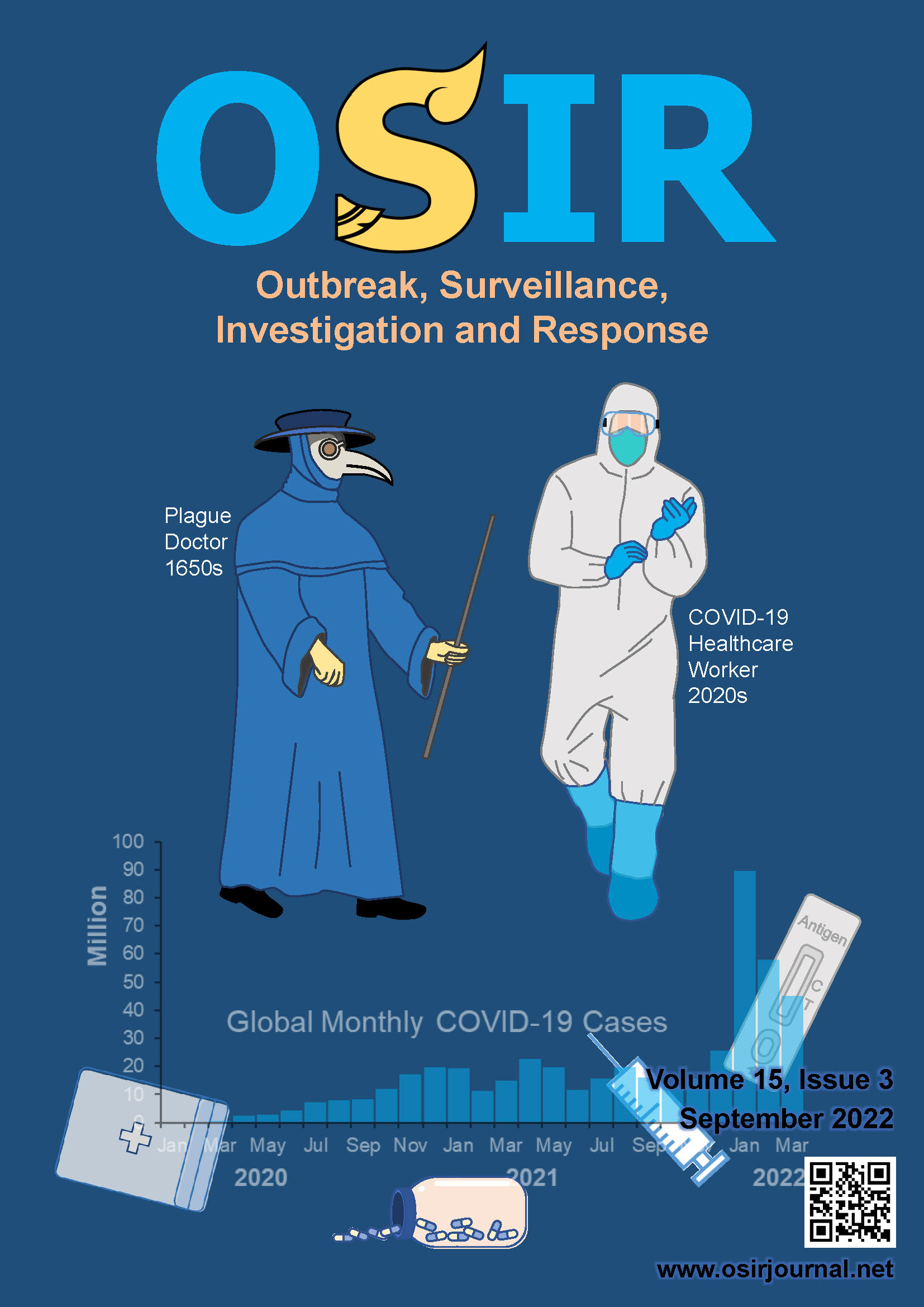Secondary Human-to-human Transmission of Nipah Virus in an Ambulance, Northwestern Bangladesh, February 2019
DOI:
https://doi.org/10.59096/osir.v15i3.262364Keywords:
Nipah virus, outbreak, Bangladesh, zoonoses, transmissionAbstract
Nipah virus (NiV) infection is a zoonotic disease with epidemic potential due to its human-to-human transmission. In Bangladesh, where NiV infection is frequent, NiV spillover from fruit bats to humans usually occurs in winter. This study aimed to describe the magnitude and scope of a NiV outbreak in February 2019, identify the source of infection, and contain the spread of disease. We interviewed the cases’ family members, conducted verbal autopsies, and collected samples for laboratory tests. Five family members reported died from, at the time, an unknown disease. All had fever, altered mental status, vomiting and diarrhea. Reverse transcription polymerase chain reaction confirmed NiV in one person. We suspected secondary transmission occurred when the family traveled with the primary case from their house to the hospital by ambulance. The trip took 8.5 hours and no one wore a face mask or gloves. The secondary attack rate among ambulance travelers was 67%. In this outbreak, NiV was transmitted human-to-human among riders in the ambulance. We recommend that everyone should use protective measures while traveling with suspected NiV infected patients to reduce the risk of transmission. Strengthening the existing Nipah virus surveillance system may generate earlier notification and response to contain further transmission.
References
World Health Organization. WHO publishes list of top emerging diseases likely to cause major epidemics [Internet]. Geneva: World Health Organization; 2015 Dec 10 [cited 2020 Aug 16]. <https://www.who.int/news/item/10-12-2015-who-publishes-list-of-top-emerging-diseases-likely-to-cause-major-epidemics>
Lam SK, Chua KB. Nipah virus encephalitis outbreak in Malaysia. Clin Infect Dis. 2002 May 1;34 Suppl 2:S48–51.
Chadha MS, Comer JA, Lowe L, Rota PA, Rollin PE, Bellini WJ, et al. Nipah virus-associated encephalitis outbreak, Siliguri, India. Emerg Infect Dis. 2006 Feb;12(2):235–40.
Ching PKG, de los Reyes VC, Sucaldito MN, Tayag E, Columna-Vingno AB, Malbas FF, et al. Outbreak of Henipavirus Infection, Philippines, 2014. Emerg Infect Dis. 2015 Feb;21(2):328–31.
Flora MS, Salimuzzaman M, Alamgir ASM, Sultana S, Muraduzzaman AKM, editors. National guideline for management, prevention and control of Nipah virus infection including encephalitis [Internet]. 2nd ed. Dhaka (BD): Institute of Epidemiology, Disease Control and Research; 2016 Nov [cited 2020 Nov 13]. <https://iedcr.gov.bd/publication/guidelines/10adb7d5-b36b-4e87-a37c-7fc981f4f888>
Institute of Epidemiology, Disease Control and Research. Nipah virus transmission in Bangladesh [Internet]. Dhaka: Institute of Epidemiology, Disease Control and Research; [cited 2020 Nov 14]. <https://iedcr.gov.bd/surveillances/93c87e70-9c22-4f21-9506-a1161ecf404f>
Luby SP, Hossain MJ, Gurley ES, Ahmed BN, Banu S, Khan SU, et al. Recurrent Zoonotic Transmission of Nipah Virus into Humans, Bangladesh, 2001–2007. Emerg Infect Dis. 2009 Aug;15(8):1229–35.
Homaira N, Rahman M, Hossain MJ, Epstein JH, Sultana R, Khan MSU, et al. Nipah virus outbreak with person-to-person transmission in a district of Bangladesh, 2007. Epidemiol Infect. 2010 Nov;138(11):1630–6.
Sazzad HMS, Hossain MJ, Gurley ES, Ameen KMH, Parveen S, Islam MS, et al. Nipah virus infection outbreak with nosocomial and corpse-to-human transmission, Bangladesh. Emerg Infect Dis. 2013 Feb;19(2):210–7.
Islam M, Sazzad H, Satter S, Sultana S, Hossain M, Hasan M, et al. Nipah virus transmission from bats to humans associated with drinking traditional liquor made from date palm sap, Bangladesh, 2011–2014. Emerg Infect Dis. 2016 Apr [cited 2018 Mar 21];22(4):664–70. <https://wwwnc.cdc.gov/eid/article/22/4/15-1747_article>
Rahman M, Chakraborty A. Nipah virus outbreaks in Bangladesh: a deadly infectious disease. WHO South East Asia J Public Health. 2012 Apr–Jun;1(2):208–12.
Gurley ES, Montgomery JM, Hossain MJ, Bell M, Azad AK, Islam MR, et al. Person-to-person transmission of Nipah virus in a Bangladeshi community. Emerg Infect Dis. 2007 Jul;13(7):1031–7.
Arunkumar G, Chandni R, Mourya DT, Singh SK, Sadanandan R, Sudan P, et al. Outbreak investigation of Nipah virus disease in Kerala, India, 2018. J Infect Dis [Internet]. 2019 Jun 15 [cited 2019 Feb 17];219(12):1867–78. <https://academic.oup.com/jid/advance-article/doi/10.1093/infdis/jiy612/5144922>
Nikolay B, Salje H, Hossain MJ, Khan AKMD, Sazzad HMS, Rahman M, et al. Transmission of Nipah virus — 14 years of investigations in Bangladesh. N Engl J Med. 2019 May 9;380(19):1804–14.
Institute of Epidemiology, Disease Control and Research. Surveillance [Internet]. Dhaka: Institute of Epidemiology, Disease Control and Research; [cited 2020 Sep 21]. Available from: <https://www.iedcr.org/index.php?option=com_content&view=article&id=42&Itemid=99>
Giesecke J. Primary and index cases. Lancet. 2014 Dec 6;384(9959):2024.
Homaira N, Rahman M, Hossain MJ, Nahar N, Khan R, Rahman M, et al. Cluster of Nipah Virus Infection, Kushtia District, Bangladesh, 2007. PLoS ONE [Internet]. 2010 Oct 21 [cited 2020 Jan 26];5(10):e13570. <https://www.ncbi.nlm.nih.gov/pmc/articles/PMC2958840/>
Lo MK, Lowe L, Hummel KB, Sazzad HMS, Gurley ES, Hossain MJ, et al. Characterization of Nipah virus from outbreaks in Bangladesh, 2008–2010. Emerg Infect Dis. 2012 Feb;18(2):248–55.
Thomas B, Chandran P, Lilabi MP, George B, Sivakumar CP, Jayadev VK, et al. Nipah virus infection in Kozhikode, Kerala, South India, in 2018: epidemiology of an outbreak of an emerging disease. Indian J Community Med. 2019 Oct–Dec;44(4):383–7.
Cortes MC, Cauchemez S, Lefrancq N, Luby SP, Jahangir Hossain M, Sazzad HMS, et al. Characterization of the Spatial and Temporal Distribution of Nipah Virus Spillover Events in Bangladesh, 2007–2013. J Infect Dis. 2018 May 1;217(9):1390–4.
Downloads
Published
How to Cite
Issue
Section
License
Copyright (c) 2023 Outbreak, Surveillance, Investigation & Response (OSIR) Journal

This work is licensed under a Creative Commons Attribution-NonCommercial-NoDerivatives 4.0 International License.









